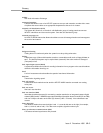
Glossary
Issue 2 December 1995 GL-3
AUDIX
See
Audio Information Exchange
.
automated attendant
A feature that allows a user of an INTUITY system to set up a main extension number with a menu
of options that routes callers to an appropriate department at the touch of a button.
automatic call distribution (ACD)
The System 85, Generic 2, or Generic 3 call-distribution group of analog ports that connects
INTUITY subscribers and users to the system. See also
call-distribution group
.
automatic message scan
An INTUITY AUDIX feature that allows subscribers to scan all message headers and messages at
the touch of two buttons.
B
background testing
Testing that runs continuously when the system is not busy doing other tasks.
backup
A duplicate copy of files and directories saved on a removable media such as floppy diskette or
tape. The backup filesystem may be copied back (restored) if the active version is damaged
(corrupted) or lost.
basic input/output system (BIOS)
A system that contains the buffers for sending information from a program to the actual hardware
device the information should go to.
baud
A unit of measurement that describes the speed of transferred information.
baud rate
Transmission signaling speed.
basic call transfer
A switchhook-flash method used to send the INTUITY AUDIX transfer command over analog
voice ports.
basic rate access
See
basic rate interface
.
basic rate interface (BRI)
International standard protocol for connecting a station terminal to an integrated systems digital
network (ISDN) switch. ISDN BRI supports two 64 Kbps information bearer channels (B1 and B2),
and one 16 Kbps call status and control (D) channel (a 2B + D format). Also called b
asic rate
access
.
binary digit (bit)
Two-number notation that uses the digits 0 and 1. Low-order bits are on the right (for example,
0001=1, 0010=2, and so forth). Four bits make a nybble; eight bits make a byte.
binary synchronous communications (BSC)
A character-oriented synchronous link protocol.


















